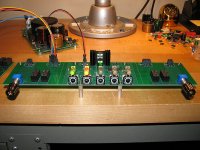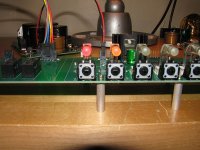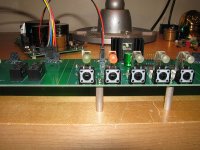Here is my idea of a cool source controller... front end for the B1, if you will.
I like the idea of 2 separate pots for each channel. But how to match the level?
I guess this is more for anal people (like me 😀). Well, you measure the voltage
out of the pot.
It works like this:
The controller has the input selection via relays (4 total inputs for each channel)
and a mute relay. In addition, there are relays that apply 5v to the pot and a
microcontroller with an A/D converter measures the voltage on the wiper. There
are 2 sets of everything, one set for each channel. This setup can be a true
"dual mono" preamp/buffer. The relays that apply the voltage to the pot also
connect the digital ground to the analog ground. When in normal listen mode,
there are no connections between the digital circuit and the analog circuit.
Furthermore, the A/D converters are not sampling during listen mode, so there
really isn't any way for noise to pollute the analog signal. There are 2 modes,
listen and mute. Whenever the mute is active, then so is the matching
function. The left-most button activates the mute. Each input has it's own
indicator LED and the Mute/Match indicator is a green/red bicolor LED that
lights up red when not matched and changes to green when both channels
are matched.
This concept allow any pots to be used, you can even use different values
because it is simply measuring the divided voltage on the output of the pot.
If you use a linear pot, then the full 10-bit resolution of the A/D can be used
for 1024 levels, including ground. The matching depends on the performance
of the A/D, which I haven't investigated yet. The first prototypes have log
taper pots, which forced me to divide down the sample value to an 8-bit
number so that the channels could be matched at higher parts of the taper
where a tiny touch of the knob results in a large resistance change.
I plan to change the board layout again to not have the pot mounted on it.
That way I can experiment with different pots and choose the ones that I like
the sound of. I ordered some precision multi-turn wire-wound pots to try out.
This concept is probably the only way a multi-turn pot is practical!
It's a work in progress, but so far it works quite well (at matching). I haven't
put everything together yet to make a complete unit, but I'm getting there.
😎
I like the idea of 2 separate pots for each channel. But how to match the level?
I guess this is more for anal people (like me 😀). Well, you measure the voltage
out of the pot.
It works like this:
The controller has the input selection via relays (4 total inputs for each channel)
and a mute relay. In addition, there are relays that apply 5v to the pot and a
microcontroller with an A/D converter measures the voltage on the wiper. There
are 2 sets of everything, one set for each channel. This setup can be a true
"dual mono" preamp/buffer. The relays that apply the voltage to the pot also
connect the digital ground to the analog ground. When in normal listen mode,
there are no connections between the digital circuit and the analog circuit.
Furthermore, the A/D converters are not sampling during listen mode, so there
really isn't any way for noise to pollute the analog signal. There are 2 modes,
listen and mute. Whenever the mute is active, then so is the matching
function. The left-most button activates the mute. Each input has it's own
indicator LED and the Mute/Match indicator is a green/red bicolor LED that
lights up red when not matched and changes to green when both channels
are matched.
This concept allow any pots to be used, you can even use different values
because it is simply measuring the divided voltage on the output of the pot.
If you use a linear pot, then the full 10-bit resolution of the A/D can be used
for 1024 levels, including ground. The matching depends on the performance
of the A/D, which I haven't investigated yet. The first prototypes have log
taper pots, which forced me to divide down the sample value to an 8-bit
number so that the channels could be matched at higher parts of the taper
where a tiny touch of the knob results in a large resistance change.
I plan to change the board layout again to not have the pot mounted on it.
That way I can experiment with different pots and choose the ones that I like
the sound of. I ordered some precision multi-turn wire-wound pots to try out.
This concept is probably the only way a multi-turn pot is practical!
It's a work in progress, but so far it works quite well (at matching). I haven't
put everything together yet to make a complete unit, but I'm getting there.
😎
Attachments
I calculated the channel matching accuracy and it turns out to be quite good.
Assuming a bit error of the A/D converter of + or - 1/2 LSB, the channel to
channel matching is + or - .004 dB at full volume and .267 dB at 1/64th volume.
The matching error is worst at very low volume levels because the bit error of
the A/D is a fixed value regardless of where the level control position is set. I
didn't calculate the error for each of the possible 1023 levels, only for a reasonable
range of 1/64th to full volume. I think this accuracy is great and I can't wait to
get everything put together! 😀
Assuming a bit error of the A/D converter of + or - 1/2 LSB, the channel to
channel matching is + or - .004 dB at full volume and .267 dB at 1/64th volume.
The matching error is worst at very low volume levels because the bit error of
the A/D is a fixed value regardless of where the level control position is set. I
didn't calculate the error for each of the possible 1023 levels, only for a reasonable
range of 1/64th to full volume. I think this accuracy is great and I can't wait to
get everything put together! 😀
Attachments
I wondered about doing this some time ago, before going for a relay controlled system.
How quickly does your system change to the desired setting?
How quickly does your system change to the desired setting?
Lovely concept. Now even the deaf will be able to enjoy a perfectly centered stereo image by just looking at an led and having a steady hand. But isn't this still too difficult? How about one pot is set by hand and the other is motorised and automatically matches the position?
Wouldn't this be good hooked up to a Lightspeed?
Technically, yes, only the entire point of Lightspeed is to avoid relays and mechanical contacts.
I wondered about doing this some time ago, before going for a relay controlled system.
How quickly does your system change to the desired setting?
It is very quick. The A/D samples many times per second.
Lovely concept. Now even the deaf will be able to enjoy a perfectly centered stereo image by just looking at an led and having a steady hand. But isn't this still too difficult? How about one pot is set by hand and the other is motorized and automatically matches the position?
A motorized pot is feasible, even remote control with 2 motorized pots, but that
is not the kind of complexity I want. I am perfectly content with manual controls.
- Status
- Not open for further replies.
- Home
- Amplifiers
- Pass Labs
- Novel Control for B1 (input and level)


